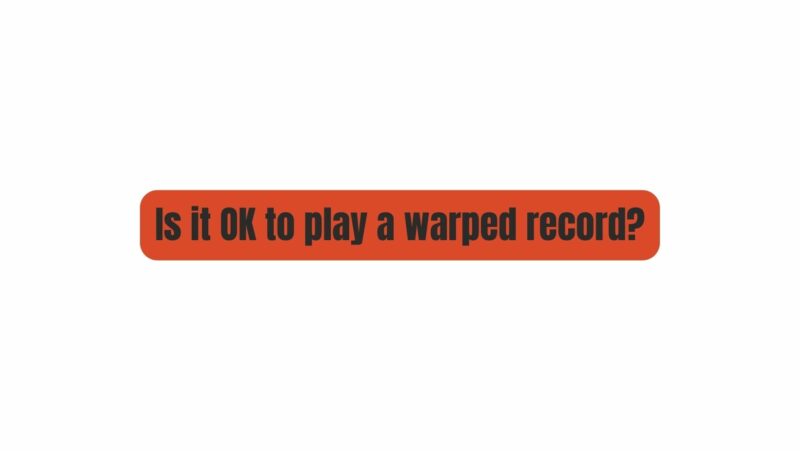Vinyl records, with their warm, analog sound and tangible connection to music’s past, have experienced a remarkable resurgence in recent years. Audiophiles and collectors alike treasure the unique experience of handling vinyl, from the delicate art of cueing the stylus to the immersive journey into the music. However, a common challenge that vinyl enthusiasts encounter is the presence of warped records. When a vinyl record takes on a wavy or uneven shape, it raises the question: Is it okay to play a warped record? In this article, we will explore the effects of playing warped vinyl records, potential risks, and strategies to minimize damage while still enjoying your cherished vinyl collection.
Understanding Warped Vinyl Records
A warped vinyl record is one that has deviated from its original flat, even shape, resulting in a wavy or distorted surface. This distortion can be a result of various factors, including manufacturing defects, storage conditions, environmental factors, or improper weight distribution.
Causes of Warped Vinyl Records
Before delving into whether it’s okay to play a warped record, let’s briefly examine what causes records to warp:
- Manufacturing Defects: Poor quality control during the vinyl pressing process can lead to uneven thickness or the uneven distribution of vinyl material, which can result in warping.
- Storage Conditions: Incorrect storage practices, such as stacking records horizontally or exposing them to excessive heat, can encourage warping over time.
- Environmental Factors: Vinyl records are sensitive to changes in temperature and humidity. Extreme variations can cause the vinyl to expand or contract unevenly, leading to warping.
- Improper Weight Distribution: Storing records with an uneven weight distribution, such as stacking them with heavy objects on top, can promote warping.
Effects of Playing Warped Vinyl Records
Playing a warped vinyl record can have several implications, both for the record itself and the listening experience:
- Audible Distortion: The most immediate effect is audible distortion during playback. As the stylus navigates the uneven surface, it may produce fluctuations in pitch and speed, resulting in a distorted and unpleasant listening experience.
- Stylus and Groove Damage: Repeated playback on a warped record can accelerate wear and tear on both the stylus and the grooves of the record. This can lead to permanent damage, reducing the longevity of both the record and the playback equipment.
- Tracking Issues: Maintaining proper tracking on a warped record can be challenging for the stylus, leading to skips and jumps during playback, further diminishing the listening experience.
Is It Okay to Play a Warped Record?
The answer to whether it’s okay to play a warped record is not straightforward and depends on several factors:
- Severity of Warping: The degree of warping is a crucial consideration. Mild warping that does not significantly affect playback may be tolerable for some listeners. However, severe warping that results in frequent skips and extreme distortion is generally not conducive to an enjoyable listening experience.
- Value of the Record: The value of the record, both monetarily and sentimentally, plays a role in the decision. Valuable or rare records are typically best preserved and played with caution, while common records may be less critical to protect.
- Playback Equipment: The quality and condition of your playback equipment are important factors. High-end turntables and cartridges may be better equipped to handle minor warping without excessive wear and tear.
- Listener Tolerance: Personal tolerance for audible distortion and imperfections in the listening experience also comes into play. Some listeners may find a certain level of warping acceptable, while others may not.
Strategies for Playing Warped Records
If you decide to play a warped record despite its imperfections, consider these strategies to minimize the potential risks:
- Gentle Playback: Use a high-quality turntable with a well-calibrated tonearm and cartridge. Ensure that the stylus is in good condition and set to the appropriate tracking force and anti-skate settings.
- Avoid Excessive Tracking Force: Adjust the tracking force to the minimum required to maintain proper tracking without causing additional wear on the stylus or the grooves.
- Skip-Proof Needles: Some specialized stylus profiles, like elliptical or line contact, may handle warped records more effectively and reduce skipping.
- Inspect the Record: Before playing, visually inspect the record for visible warping, and listen for any audible issues during the initial rotation. If severe distortion or skipping occurs, it may be best to stop playback.
- Record Flattening Machines: For valuable records with mild warping, consider using a purpose-built record flattening machine. These machines apply controlled heat and pressure to restore the record’s flat shape without causing damage.
Prevention is the Best Approach
While the decision to play a warped record ultimately depends on your tolerance for imperfections and the value of the record, prevention is the best approach to preserving your vinyl collection:
- Proper Storage: Store your records vertically in a cool, dry, and stable environment, away from direct sunlight and extreme temperature fluctuations.
- Quality Control: When purchasing new or used records, inspect them for visible warping or defects before adding them to your collection. High-quality pressings from reputable manufacturers are less likely to exhibit manufacturing defects.
Conclusion
Playing a warped vinyl record is a decision that should be made carefully, taking into consideration factors such as the severity of the warping, the value of the record, your playback equipment, and your personal tolerance for audible imperfections. While some minor warping may be tolerable for casual listening, severe warping can lead to significant audible distortion and potential damage to your record and equipment.
Ultimately, the key to preserving your cherished vinyl collection lies in prevention. Proper storage practices, quality control when acquiring records, and proactive maintenance of your playback equipment are essential steps in ensuring that you can continue to enjoy your vinyl records for years to come. Whether you choose to play a warped record or opt for alternative methods of restoration, the joy of vinyl remains in its ability to connect us to the music we love, imperfections and all.

